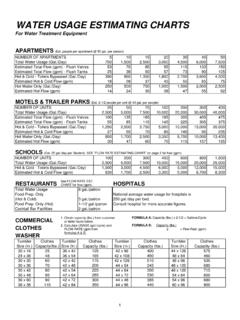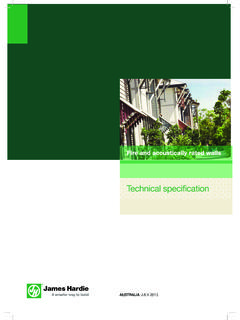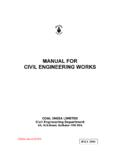Transcription of Installation Instructions and Owner’s Manual
1 First Sales, LLC 12630 US Highway 33 N Churubusco, IN 46723 Phone (260) 693-1972 Fax (260) 693-0602 OXY3-OXY3E Instruction Manual OXY3 & OXY3E Series Iron Reduction System Installation Instructions and Owner s Manual 1 Pre- Installation Instructions Page 2 General Installation Page 4 Installation Instructions Page 5 OXY3 Timer Operation Page 8 OXY3E Display and Operation Page 10 OXY3E Setting Time of Day Page 11 OXY3E Programming Page 12 Specifications Page 13 Component Parts Breakdown & List Page 14 OXY3 Control Valve Breakdown Page 15 OXY3 Control Valve Parts List Page 16 OXY3E Control Valve Breakdown Page 17 Table of Contents 2 Description of the iron filtration system The OXY3 iron filtration system includes an aeration tank, a filtration tank and a backwashing control valve.
2 Incoming water flows into the control valve and is directed into the aeration tank. Exposure to the air in this tank will begin oxidizing any clear water iron. The water then flows through the back connector tube and into the filtration tank where oxidized iron is trapped by the filter media. The iron-free water then returns to the control valve where it is directed into the service lines. Periodically the control valve will go through a backwash cycle. This cycle will typically begin at 1:00 flushing the accumulated iron to the drain. Part of this backwashing process includes an air draw cycle which will replenish the pocket of air in the aeration tank and prepare the unit for the next period of service. Water Quality While the OXY3 filter will perform under a variety of water qualities there are a few things that need to be considered to ensure satisfactory performance.
3 The water should be tested to determine the concentration, or levels of the items listed below. pH - A measurement of the acidity of the water. pH is reported on a scale from 0 to 14. Neutral water has a pH of , lower values indicate acidic water. The OXY3 iron filter performs best when the pH is , or higher. pH values below require a special media blend in the filter in order to elevate the pH for proper iron oxidation. Iron - A naturally occurring metallic element. Iron concentrations in excess of milligrams/liter (mg/l) combine with oxygen causing orange or red (rust) stains on plumbing fixtures. Iron naturally exists in some water sources in either clear water (ferrous) state, red water (ferric) state or bacterial form. The OXY3 iron filter is designed to oxidize ferrous iron so it can be removed by mechanical filtration in the ferric state.
4 By removing the available iron in the water, iron bacteria are then inhibited from propagating and forming biomass. Any biomass that forms inside the iron filter is regularly dislodged during the backwash cycle of regeneration. Manganese - A naturally occurring metallic element. Manganese concentrations as low as milligrams/liter (mg/l) can combine with oxygen to cause dark brown or black staining on fixtures. Additionally, manganese can cause an odor in the water similar to a rotten egg smell. The OXY3 iron filter reduces manganese as well as iron, however, manganese oxidation requires the pH of the water to be elevated to or higher. Special OXY3 media blends are available to elevate the pH of manganese bearing waters. Tannin - A naturally occurring humic acid. Tannin is an acid caused by water passing through decaying vegetation.
5 Coffee and Tea are prime examples of tannin in water. As hot water passes over the coffee beans, or tea leaves, the tannin is extracted causing color and flavor in the water. Tannin concentrations as low as milligrams per liter can cause a yellow discoloration in the water and may interfere with the OXY3 iron filter s long-term ability to remove the iron as the media becomes coated with the tannic acid. Hydrogen Sulfide - A naturally occurring gas. Hydrogen sulfide, more commonly referred to as sulfur gas, causes a distinct odor similar to rotten eggs. Due to its gaseous nature, hydrogen sulfide must be tested at the well site within 1 minute of drawing the sample. If a water sample has been sitting for a while the sulfur gas will dissipate and cause the hydrogen sulfide test to be lower than the actual concentration.
6 If sulfur is present, the filter should be set to backwash more frequently to prevent the gas from building up. The OXY3 iron filter can typically treat up to 2 to 3 milligrams per liter of sulfur gas. Pre- Installation Instructions 3 Water Supply Unlike other iron filters that do not use chemicals to oxidize the iron, the OXY3 iron filter does not require additional devices such as air compressors, venturis, solenoids, pressure switches or pressure tanks. This filter will function properly when the water supply is furnished by a jet pump, submersible pump, variable speed (constant pressure) pump or community water supply. As with all other filter systems, however, it is imperative that the well pump provides enough flow rate for the filter to adequately backwash. In order to ensure sufficient backwash flow rate the following pumping rate test should be performed prior to installing the iron filter.
7 1. Make certain no water is being drawn in the house. 2. Open spigot nearest pressure tank. 3. When well pump starts, close spigot and measure time (in seconds) to refill pressure tank (well pump turns back off). This is Cycle Time. 4. Using a container of known volume, draw water from pressure tank and measure how many gallons until the pump turns back on again. This is Draw Down. 5. Calculate pumping rate by dividing draw down by cycle time and multiplying by 60. Draw Down (gallons) X 60 = Pumping Rate (gallons per minute) Cycle Time (seconds) Example: Draw down is 8 gallons Cycle time is 65 seconds Location Considerations The proper location to install the OXY3 filter will ensure optimum filter performance and satisfactory water quality. The following factors should be considered in selecting the location of the iron filter.
8 1. The filter should be installed after the pressure tank (private well system only). 2. The filter should be installed as close as possible (preferably within 15 ) to an adequate floor or laundry drain capable of handling the backwash cycle volume and flow rate (refer to unit specifications). 3. All water conditioning equipment should be installed prior to the water heater. Water temperatures exceeding 100 F can damage the internal components of the control valve and filter tank. An expansion tank may need to be installed in the line to the water heater in order to allow for thermal expansion and comply with local plumbing codes. 4. The filter should not be subject to freezing temperatures. 5. The filter should be installed before a water softener (if required). 6. Never install a cartridge type filter prior to the OXY3 iron filter.
9 Any cartridge or in-line filter (if desired) should be installed after both the OXY3 filter and any softener that might be installed. This will prevent restricting the water flow and pressure available for backwash. 7. Appliances requiring extended periods of continuous or high flow water use ( geothermal heat pumps, swimming pools, lawn irrigation, outside hose bibs, etc.) should bypass the filter and a spring check valve should be installed on the filter inlet to prevent backflow of air from the aeration tank (see Installation diagram Fig. 1). 8 gallons X 60 = gpm (gallons per minute) 65 seconds Pre- Installation Instructions (cont.) 4 GENERAL Installation & SERVICE WARNINGS The water conditioner is not designed to support the weight of plumbing. Do not use Vaseline, oils, other hydrocarbon lubricants or spray silicone anywhere.
10 A silicone lubricant may be used on black O Rings. This will allow ease of Installation and decrease chance of rolling from the bypass and tank connections. Avoid any type of lubricants, including silicone, on red or clear lip seals. Do not use pipe dope or other sealants on threads. Teflon tape must be used on the threads of the drain line connection. Teflon tape is not used on any connection where O Ring seals are used NOTE: If the plumbing system is used as the ground leg of the electric supply, continuity should be maintained by installing ground straps around any non-conductive plastic piping or bypass used in the Installation . Make sure the filter is not installed backwards. The filter will not function properly if installed backwards and filter media may be forced into the water lines. Arrows molded into the valve body and into the bypass indicate the direction of flow.












